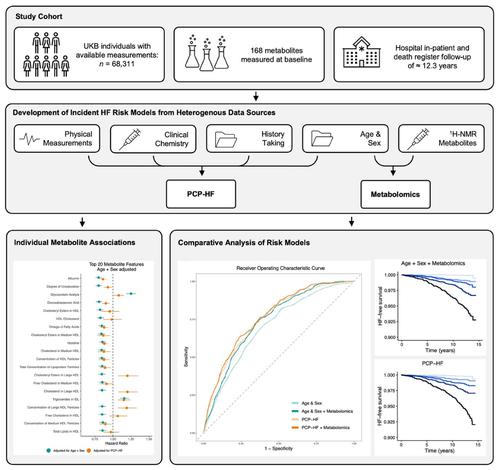当前位置:
X-MOL 学术
›
Eur. J. Heart Fail.
›
论文详情
Our official English website, www.x-mol.net, welcomes your feedback! (Note: you will need to create a separate account there.)
Serum metabolomics improves risk stratification for incident heart failure
European Journal of Heart Failure ( IF 18.2 ) Pub Date : 2024-04-16 , DOI: 10.1002/ejhf.3226 Rafael R. Oexner 1 , Hyunchan Ahn 1 , Konstantinos Theofilatos 1 , Ravi A. Shah 2 , Robin Schmitt 1 , Philip Chowienczyk 1 , Anna Zoccarato 1 , Ajay M. Shah 1
European Journal of Heart Failure ( IF 18.2 ) Pub Date : 2024-04-16 , DOI: 10.1002/ejhf.3226 Rafael R. Oexner 1 , Hyunchan Ahn 1 , Konstantinos Theofilatos 1 , Ravi A. Shah 2 , Robin Schmitt 1 , Philip Chowienczyk 1 , Anna Zoccarato 1 , Ajay M. Shah 1
Affiliation

|
AimsPrediction and early detection of heart failure (HF) is crucial to mitigate its impact on quality of life, survival, and healthcare expenditure. Here, we explored the predictive value of serum metabolomics (168 metabolites detected by proton nuclear magnetic resonance [1 H‐NMR] spectroscopy) for incident HF.Methods and resultsLeveraging data of 68 311 individuals and >0.8 million person‐years of follow‐up from the UK Biobank cohort, we (i) fitted per‐metabolite Cox proportional hazards models to assess individual metabolite associations, and (ii) trained and validated elastic net models to predict incident HF using the serum metabolome. We benchmarked discriminative performance against a comprehensive, well‐validated clinical risk score (Pooled Cohort Equations to Prevent HF [PCP‐HF]). During a median follow‐up of ≈12.3 years, several metabolites showed independent association with incident HF (90/168 adjusting for age and sex, 48/168 adjusting for PCP‐HF). Performance‐optimized risk models effectively retained key predictors representing highly correlated clusters (≈80% feature reduction). Adding metabolomics to PCP‐HF improved predictive performance (Harrel's C: 0.768 vs. 0.755, ΔC = 0.013, [95% confidence interval [CI] 0.004–0.022], continuous net reclassification improvement [NRI]: 0.287 [95% CI 0.200–0.367], relative integrated discrimination improvement [IDI]: 17.47% [95% CI 9.463–27.825]). Models including age, sex and metabolomics performed almost as well as PCP‐HF (Harrel's C: 0.745 vs. 0.755, ΔC = 0.010 [95% CI −0.004 to 0.027], continuous NRI: 0.097 [95% CI −0.025 to 0.217], relative IDI: 13.445% [95% CI −10.608 to 41.454]). Risk and survival stratification was improved by integrating metabolomics.ConclusionSerum metabolomics improves incident HF risk prediction over PCP‐HF. Scores based on age, sex and metabolomics exhibit similar predictive power to clinically‐based models, potentially offering a cost‐effective, standardizable, and scalable single‐domain alternative.
中文翻译:

血清代谢组学改善心力衰竭的风险分层
目标 心力衰竭 (HF) 的预测和早期检测对于减轻其对生活质量、生存和医疗支出的影响至关重要。在这里,我们探讨了血清代谢组学的预测价值(通过质子核磁共振检测到的 168 种代谢物[1 方法和结果利用 68 311 名个体的数据和来自英国生物银行队列的超过 80 万人年的随访,我们 (i) 拟合了每种代谢物 Cox 比例风险模型来评估个体代谢物关联,以及 (ii) 训练和验证弹性网络模型以使用血清代谢组预测心力衰竭事件。我们根据全面的、经过充分验证的临床风险评分(预防心力衰竭的队列方程 [PCP-HF])对区分性能进行基准测试。在中位随访约 12.3 年期间,几种代谢物显示出与 HF 事件独立相关(根据年龄和性别调整为 90/168,根据 PCP-HF 调整为 48/168)。性能优化的风险模型有效地保留了代表高度相关集群的关键预测因子(约 80% 特征减少)。将代谢组学添加到 PCP-HF 中可提高预测性能(Harrel's C:0.768 vs. 0.755,ΔC = 0.013,[95% 置信区间 [CI] 0.004–0.022],连续净重分类改进 [NRI]:0.287 [95% CI 0.200– 0.367],相对综合辨别力改善[IDI]:17.47% [95% CI 9.463–27.825])。包括年龄、性别和代谢组学在内的模型的表现几乎与 PCP-HF 一样好(Harrel's C:0.745 与 0.755,ΔC = 0.010 [95% CI -0.004 至 0.027],连续 NRI:0.097 [95% CI -0.025 至 0.217] ,相对 IDI:13.445% [95% CI -10.608 至 41.454])。通过整合代谢组学改善了风险和生存分层。结论血清代谢组学相对于 PCP-HF 改善了心力衰竭事件风险预测。基于年龄、性别和代谢组学的评分与基于临床的模型表现出相似的预测能力,有可能提供一种经济高效、可标准化和可扩展的单域替代方案。
更新日期:2024-04-16
中文翻译:

血清代谢组学改善心力衰竭的风险分层
目标 心力衰竭 (HF) 的预测和早期检测对于减轻其对生活质量、生存和医疗支出的影响至关重要。在这里,我们探讨了血清代谢组学的预测价值(通过质子核磁共振检测到的 168 种代谢物[



























 京公网安备 11010802027423号
京公网安备 11010802027423号